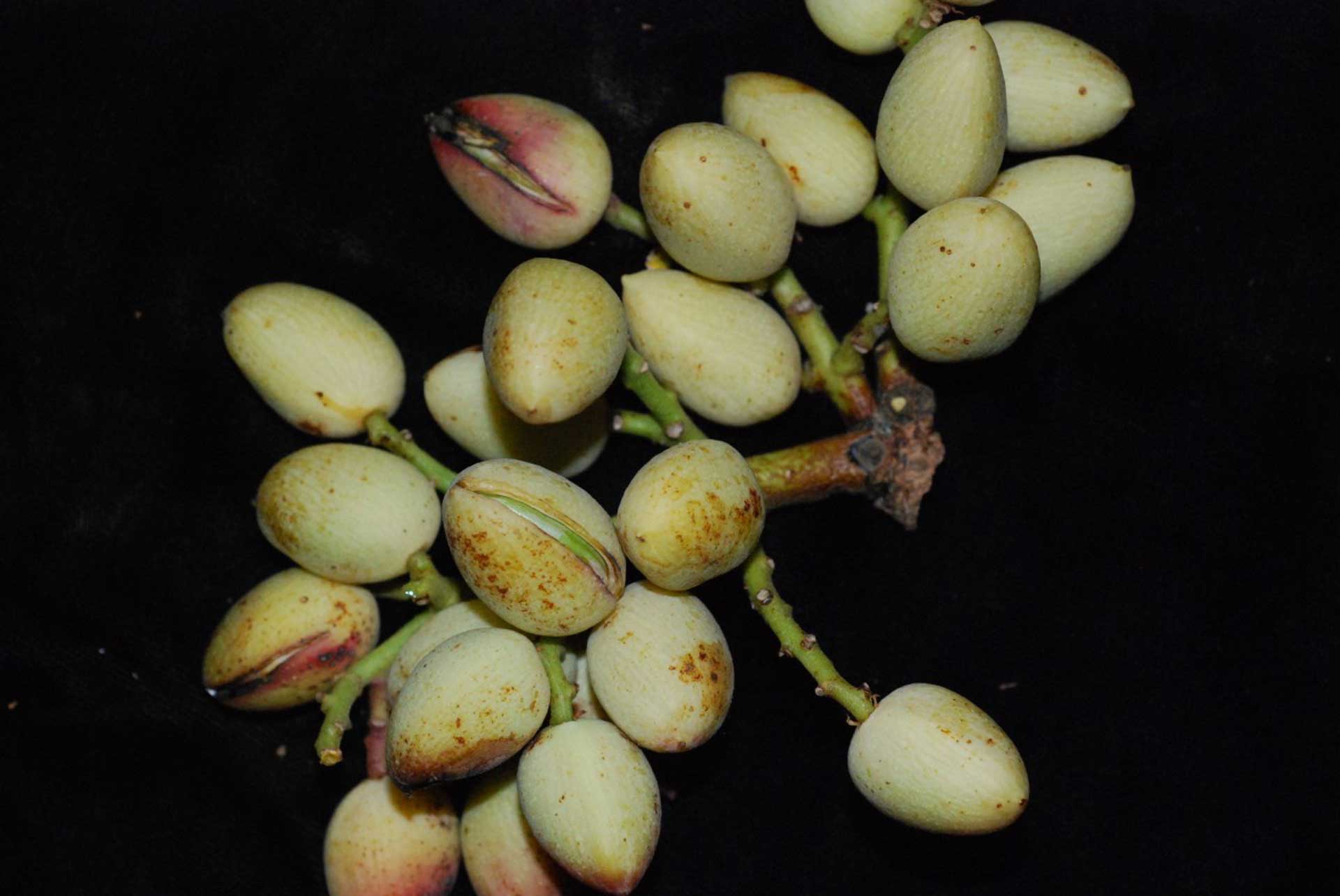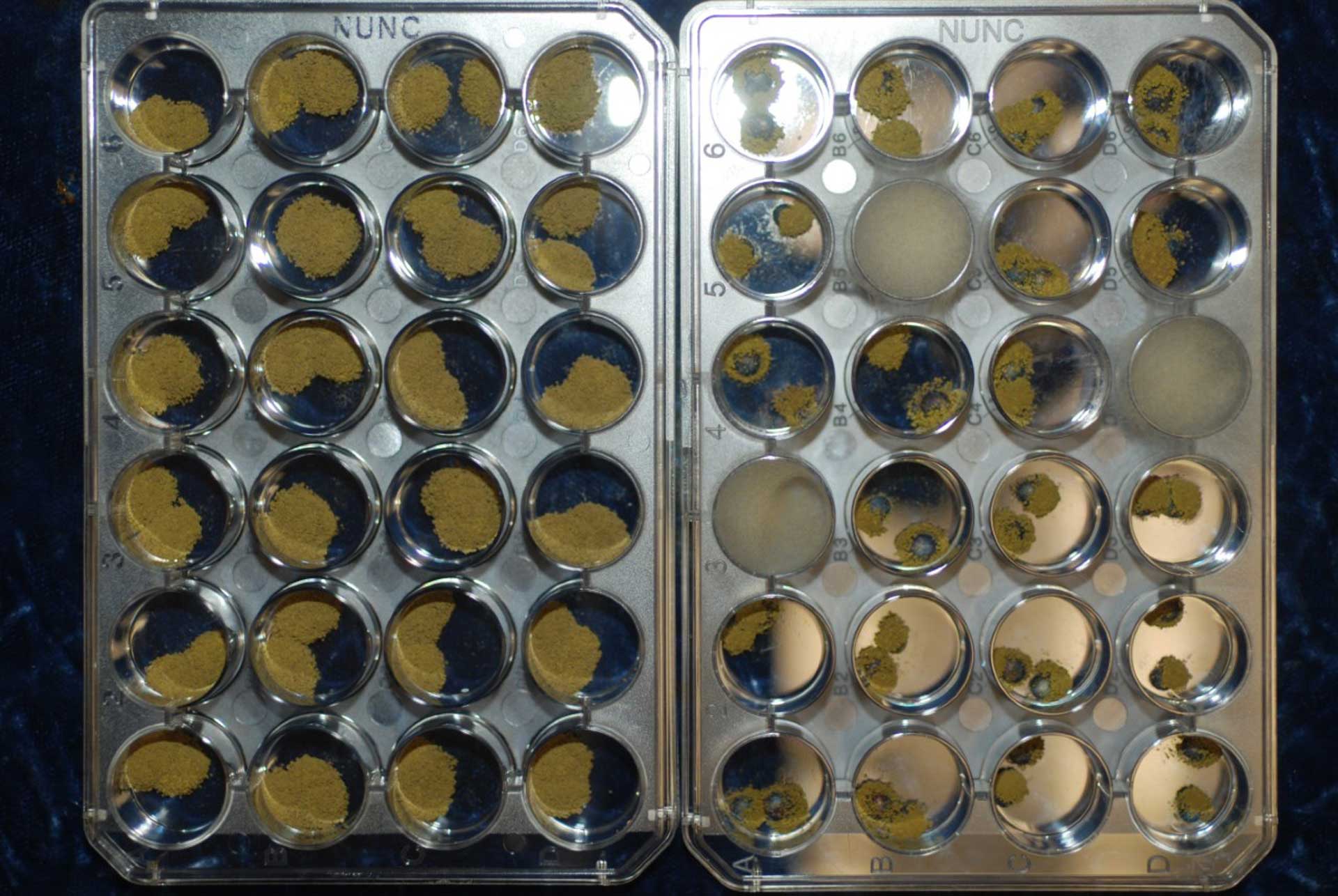
Research is showing that an areawide approach may be necessary for pistachio growers to optimize a biological control program for aflatoxin.
Speaking at UC ANR Statewide Pistachio Day on Jan. 20, UC Davis Plant Pathologist Themis Michailides said the research is showing that where large blocks of pistachios and almonds are treated with the biological control agent Aspergillus Flavus 36 Prevail, the efficacy improves dramatically over cases where adjacent orchards are left untreated.
Under existing practices, the biological control agent, which is an atoxigenic strain of Aspergillus, is displacing 50% to 70% of the toxigenic strain of Aspergillus when used in California pistachio orchards, Michailides said. This is well below displacement levels cotton and corn producers in Arizona and Texas are achieving under the program and also below what initial research indicated was possible in pistachios.
“In Arizona, where this material is applied to reduce aflatoxin in cotton seed and in corn in Texas, they get consistently 80% to 90%+ displacement,” Michailides said, “and that results in very significant reduction of positive samples of aflatoxin.”
Aflatoxins are subject to strict regulatory limits in the U.S. and European food markets. Allowances for almonds and pistachios are capped at 20 parts per billion (ppb) in the U.S. and 10 ppb in Europe, with that dropping to 8 ppb for the B1 aflatoxin.
Aflatoxin contamination also makes up the highest percentage of incidents in the Rapid Alert System for Feed and Food notifications, a system for reporting food safety issues in the European Union, making up between 50% to 76% of the alerts between 2014 and 2018. At 14% to 39%, ochratoxin alerts are a distant second in percentage of alerts.
Biological control of aflatoxin was among several approaches for minimizing aflatoxin contamination in pistachios that Michailides addressed in his presentation.

Early Splits and NOW
Among other approaches, Michailides said it is critical to avoid tree stress and subsequent development of early splits by applying sufficient irrigation early in the season.
“[Early splits] are very good sores for infection by Aspergillus fungi and infestation by the navel orangeworm,” Michailides said.
He added that experiments have shown that trees stressed early in the season are more susceptible to early splits.
Rootstock selection also can help reduce early splits, given that some are more prone to early splits development than others. In experiments, UCB1 and PGI (Pioneer Gold) had lower incidence of early splits than Pistacia atlantica and PGII, he said.
Reducing navel orangeworm (NOW) populations through chemical and cultural control programs, such as orchard sanitation during fall and winter months, can be critical to minimizing aflatoxin levels, he said. Not only does NOW create wounds that can be an avenue for Aspergillus to infect nuts, it can also carry spores of Aspergillus for infection.
“In lab studies, we have shown that as you reduce the damage of NOW, there is a linear correlation in the reduction of aflatoxin positives,” he said.
Also, he said, removing mummies is important to reducing levels of Aspergillus in an orchard, given that some may be infected when they fall to the ground, and these can subsequently introduce Asp
ergillus to soil. The fungi then can become airborne on the dust of soil and can reach canopies and infect nuts.
Another key approach to minimizing aflatoxin in pistachios involves timely harvest, he said, specifically avoiding late harvests if possible.
“The amounts of aflatoxins increase as we delay harvest,” Michailides said. “In fact, the re-shakes will have the highest incidence of positives and also the highest amounts of aflatoxin.”
It also is important for processing plants to sort out defective nuts to minimize aflatoxin levels in pistachios, he said.
AF36 Biological Approach
Michailides noted, however, that even after incorporating all of these measures, growers can still have issues with aflatoxin. “And that is why we move to new approaches and to use a biological control of aflatoxin by using the atoxigenic strains of Aspergillus flavus, or strains that do not produce aflatoxin.”
Biological control programs to date have involved applying the atoxigenic strain to orchards with the intent of displacing the toxigenic strains. Four years of research showed displacement rates of 90% to 95% in pistachios, which led to an average of 40% reduction in aflatoxin contaminated pistachios in the first harvest and up to a 55% reduction in re-shakes.
Additional research, which involved inoculating pistachio fruit with toxigenic and atoxigenic Aspergillus, also showed a significant reduction in aflatoxin contamination, including the highly regulated aflatoxin B1.
“So, this tells us that if a nut is infected with both strains, the toxigenic and AF36, aflatoxin will not be produced,” Michailides said.
In researching methods to improve the performance of biological control programs, researchers (Drs. Ramon Jaime and Michailides) compared the treatment efficacy based on whether adjacent orchards were also treated. In the experiment, researchers were able to achieve atoxigenic displacement rates of between 75% to 95% in the treated blocks that were surrounded by other treated blocks. This is well above what they were able to achieve in orchards adjacent to untreated blocks and well above the industry’s current displacement rates.
“That indicates to us that we are going in the right direction to reduce the incidence of aflatoxin positive samples even more,” he said regarding support of areawide biological control programs.
A similar study in almonds also showed an improved displacement rate when a treated orchard is surrounded by other treated blocks and a lower displacement rate when adjacent blocks were untreated. Researchers were able to achieve an 80% displacement rate in this study, he said, despite very high levels of toxigenic strains in the treated orchard’s soils.
New Product
Up until this past year, the sole biological control product for aflatoxin registered for use in California pistachios, almonds and figs was AF36 Prevail. Produced by the Arizona Research Protection Council, it uses milo as its carrier.
Last summer, an additional atoxigenic strain of Aspergillus flavus was approved for use in California pistachios, almonds, peanuts and corn. Called Afla-Guard GR, the product, produced by Syngenta, uses barley as its carrier.
In experiments, Afla-Guard sporulated well under relatively low temperatures and low moisture and at high humidity. And the product held up well to ant and beetle predation, Michailides said.
Growers should irrigate just prior or immediately after application of the two biological control products, Michailides said, and avoid spraying herbicides for one to two weeks after application.
He added that there are no negative effects from switching to Afla-Guard after several years of using AF36 Prevail if growers so desire.










